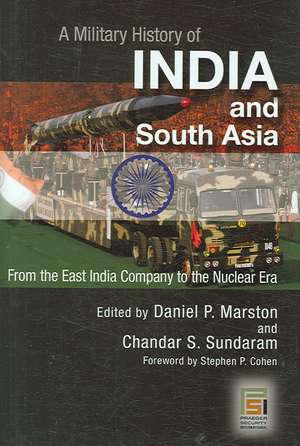A Military History of India and South Asia: From the East India Company to the Nuclear Era
Editat de Daniel P. Marston D. Phil., Chandar S. Sundaramen Limba Engleză Hardback – 29 dec 2006 – vârsta până la 17 ani
Preț: 462.61 lei
Preț vechi: 609.44 lei
-24% Nou
Puncte Express: 694
Preț estimativ în valută:
88.52€ • 94.66$ • 73.81£
88.52€ • 94.66$ • 73.81£
Carte tipărită la comandă
Livrare economică 18 aprilie-02 mai
Preluare comenzi: 021 569.72.76
Specificații
ISBN-13: 9780275985707
ISBN-10: 0275985709
Pagini: 256
Dimensiuni: 156 x 235 x 25 mm
Greutate: 0.55 kg
Editura: Bloomsbury Publishing
Colecția Praeger
Locul publicării:New York, United States
ISBN-10: 0275985709
Pagini: 256
Dimensiuni: 156 x 235 x 25 mm
Greutate: 0.55 kg
Editura: Bloomsbury Publishing
Colecția Praeger
Locul publicării:New York, United States
Notă biografică
Daniel P. Marston is Senior Lecturer in the Department of War Studies at the Royal Military Academy, Sandhurst (U.K.). He has written Phoenix from the Ashes: The Indian Army in the Burma Campaign (Praeger 2003) and is editor-in-chief for The Pacific War Companion (2005).Chandar S. Sundaram teaches South Asian, Southeast Asian, European, and military history at The United International College in Zhuhai, China. He has published on the Indian National Army, the Indianization of the colonial Indian Army, and South Asian Warfare and Society. He is currently researching the military culture of the late-colonial Indian Army.
Recenzii
This volume contains 13 first-rate essays by new South Asian scholars. They demonstrate that East India Company trade depended upon military superiority; that the British learned how to strengthen ties between officers and sepoys after the 1857 mutiny; and that crystallization of the martial race theory was part of imperial strategy..Highly recommended. All levels/libraries.
South Asia's geography and politics is of key interest to the developing nations, and so A Military History of India and South Asia From the East India Company to the Nuclear Era should be on the shelves of any college-level collection, whether it be military or civilian in nature. Collections also strong in Asian history and culture will find this history important: it surveys the region since 1700, covering major conflicts, ideological and social differences, military encounters, and more. Experts contribute chapters strongly supported by source materials and research.
This is both a solid introduction and also a thought-provoking text for those with some prior knowledge of the Indian Army.
Complaining that Indian military history has been grossly neglected by the South Asian studies community and by military historians, Marston and Sundaram present a varied collection of 13 papers that both distill work by established scholars and present new and original research on military history in the South Asian subcontinent. As the title implies, the opening paper examines the armed expansion of the English East India Company from the mid-18th to the mid-19th century and the final paper analyzes India's current nuclear policy. Between these bookends are examinations of army training at the Northwest frontier (1901-1947), the performance of the Indian Army in the First World War, the Indianization of the officer corps (1817-1940), the Indian wars with China and Pakistan, and the conflict between the Tamil Tigers and the government forces of Sri Lanka.
. . . those who are interested in the military history of South Asia since the mid-eighteenth century will find it a great pleasure to read.
South Asia's geography and politics is of key interest to the developing nations, and so A Military History of India and South Asia From the East India Company to the Nuclear Era should be on the shelves of any college-level collection, whether it be military or civilian in nature. Collections also strong in Asian history and culture will find this history important: it surveys the region since 1700, covering major conflicts, ideological and social differences, military encounters, and more. Experts contribute chapters strongly supported by source materials and research.
This is both a solid introduction and also a thought-provoking text for those with some prior knowledge of the Indian Army.
Complaining that Indian military history has been grossly neglected by the South Asian studies community and by military historians, Marston and Sundaram present a varied collection of 13 papers that both distill work by established scholars and present new and original research on military history in the South Asian subcontinent. As the title implies, the opening paper examines the armed expansion of the English East India Company from the mid-18th to the mid-19th century and the final paper analyzes India's current nuclear policy. Between these bookends are examinations of army training at the Northwest frontier (1901-1947), the performance of the Indian Army in the First World War, the Indianization of the officer corps (1817-1940), the Indian wars with China and Pakistan, and the conflict between the Tamil Tigers and the government forces of Sri Lanka.
. . . those who are interested in the military history of South Asia since the mid-eighteenth century will find it a great pleasure to read.
